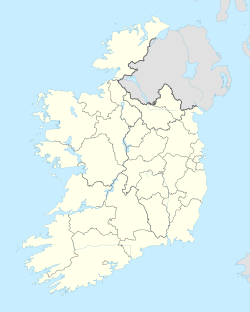world.wikisort.org - Ireland
Béal na Bláth or Béal na Blá (anglicised Bealnablath or Bealnabla)[1][2] is a small village on the R585 road in County Cork, Ireland. The area is best known as the site of the ambush and death of the Irish revolutionary leader Michael Collins in 1922.
Béal na Bláth | |
|---|---|
Village | |
 Cross commemorating where Michael Collins, leader of the National Army, was killed in August 1922 | |
 Béal na Bláth Location in Ireland | |
| Coordinates: 51.821751°N 8.855673°W | |
| Country | Ireland |
| Province | Munster |
| County | County Cork |
Michael Collins
On 22 August 1922, during the Irish Civil War, Michael Collins, Chairman of the Provisional Government and Commander-in-chief of the National Army, was killed in an ambush near Béal na Bláth by anti-treaty IRA forces while travelling in convoy from Bandon. The ambush was planned in a farmhouse in the village close to The Diamond Bar.[3] Commemorations are held on the nearest Sunday to the anniversary of his death. A memorial cross (coordinates 51.81356°N 8.85651°W) stands 1 km south of the village, at the site of the shooting in the townland of Glannarogue (in Irish, Gleann na Ruaige), on a local road which was a dirt road when Collins was shot.[4] A small white pillar marked with a cross, located just to the right of the steps, marks the exact spot where he fell.[citation needed]
Name
The original version of the name has become obscured with the passage of time. The Placenames Database of Ireland gives the official spelling as Béal na Blá, with the alternative Béal na Bláth.[2] The two anglicisations are 'Bealnabla' and 'Bealnablath'.[2] Béal means "mouth/opening/approach".[2] The meaning of blá in this placename is asserted by academic authorities to mean "pasture-land", "good land",[4] "green" or "lawn",[2] while bláth can mean "blossom" or "buttermilk".[5]
The spelling Béal na mBláth (meaning "mouth of the flowers") is commonly used but does not fit with the pronunciation used by the last native Irish-language speakers in the area (who survived until the 1940s), nor does it accord with the historical record.[5][4] This spelling of the name, and the associated translation, most likely arose through folk etymology among non-native speakers.[5] Another suggested reconstruction of the original name is Béal Átha na Bláiche, meaning "mouth of the ford of the buttermilk", by analogy to a similar placename in County Limerick.[5]
References
- "Béal na Blá/Bealnablath". logainm.ie. Retrieved 22 August 2022.
- "Béal na Blá/Bealnablath". Placenames Database of Ireland.
- Hopkinson, Michael. Green Against Green: the Irish civil war, 1988, p. 177.
- Marian O'Flaherty, 'What's in a name: Béal na Blá, Béal na Bláth or Gleann na Ruaige?. RTÉ News, 20 August 2022, retrieved 20 August 2022
- Ó hÚrdail, Roibeárd (1999), "The Placename Béal na Blá", Journal of the Cork Historical and Archaeological Society, 104: 111–116
Другой контент может иметь иную лицензию. Перед использованием материалов сайта WikiSort.org внимательно изучите правила лицензирования конкретных элементов наполнения сайта.
WikiSort.org - проект по пересортировке и дополнению контента Википедии
